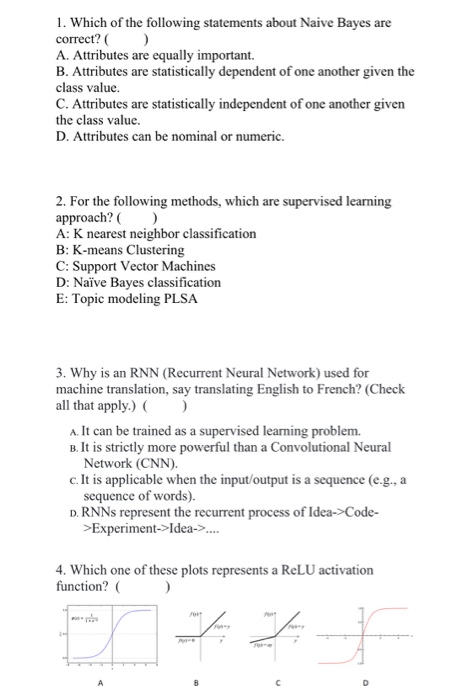Answered step by step
Verified Expert Solution
Question
1 Approved Answer
1. Which of the following statements about Naive Bayes are correct? ( ) A. Attributes are equally important. B. Attributes are statistically dependent of

1. Which of the following statements about Naive Bayes are correct? ( ) A. Attributes are equally important. B. Attributes are statistically dependent of one another given the class value. C. Attributes are statistically independent of one another given the class value. D. Attributes can be nominal or numeric. 2. For the following methods, which are supervised learning approach? ( ) A: K nearest neighbor classification B: K-means Clustering C: Support Vector Machines D: Nave Bayes classification E: Topic modeling PLSA 3. Why is an RNN (Recurrent Neural Network) used for machine translation, say translating English to French? (Check all that apply.) ( ) A. It can be trained as a supervised learning problem. B. It is strictly more powerful than a Convolutional Neural Network (CNN). c. It is applicable when the input/output is a sequence (e.g., a sequence of words). D. RNNs represent the recurrent process of Idea->Code- >Experiment->Idea->.... 4. Which one of these plots represents a ReLU activation function? ( ) EX 7017 Fo 7601
Step by Step Solution
★★★★★
3.37 Rating (163 Votes )
There are 3 Steps involved in it
Step: 1
1 Attributes or prdictors are staticall independent of each other this is the prime assumption of na...
Get Instant Access to Expert-Tailored Solutions
See step-by-step solutions with expert insights and AI powered tools for academic success
Step: 2

Step: 3

Ace Your Homework with AI
Get the answers you need in no time with our AI-driven, step-by-step assistance
Get Started


